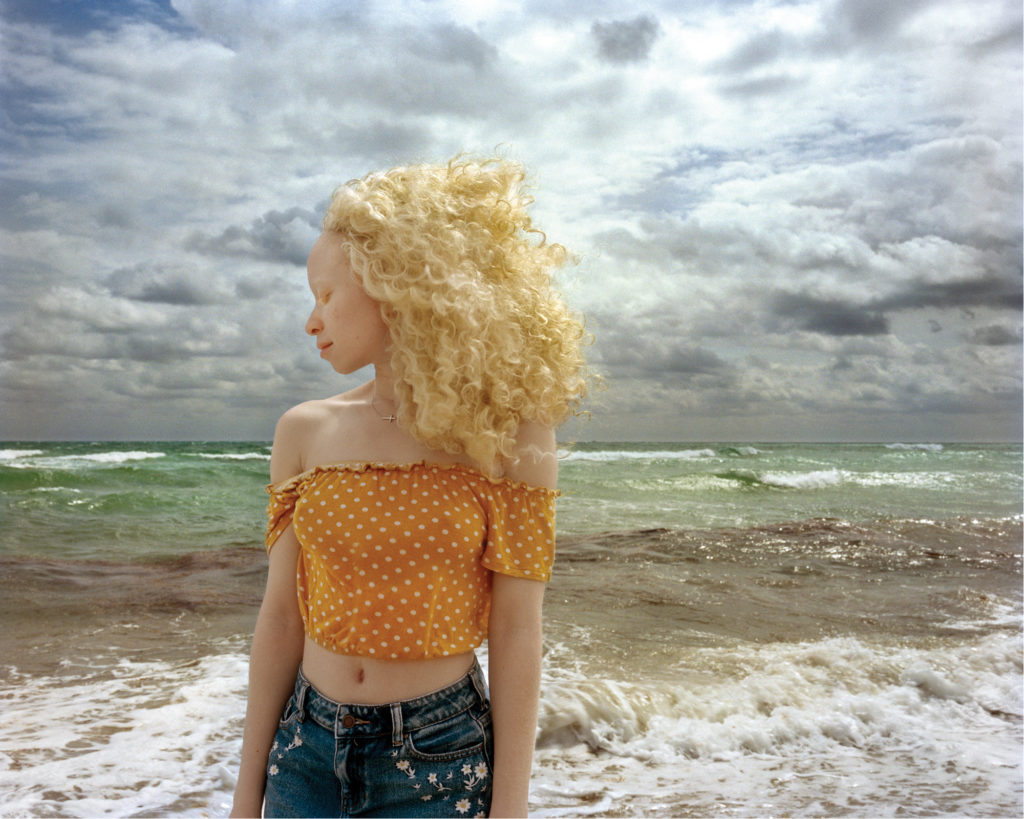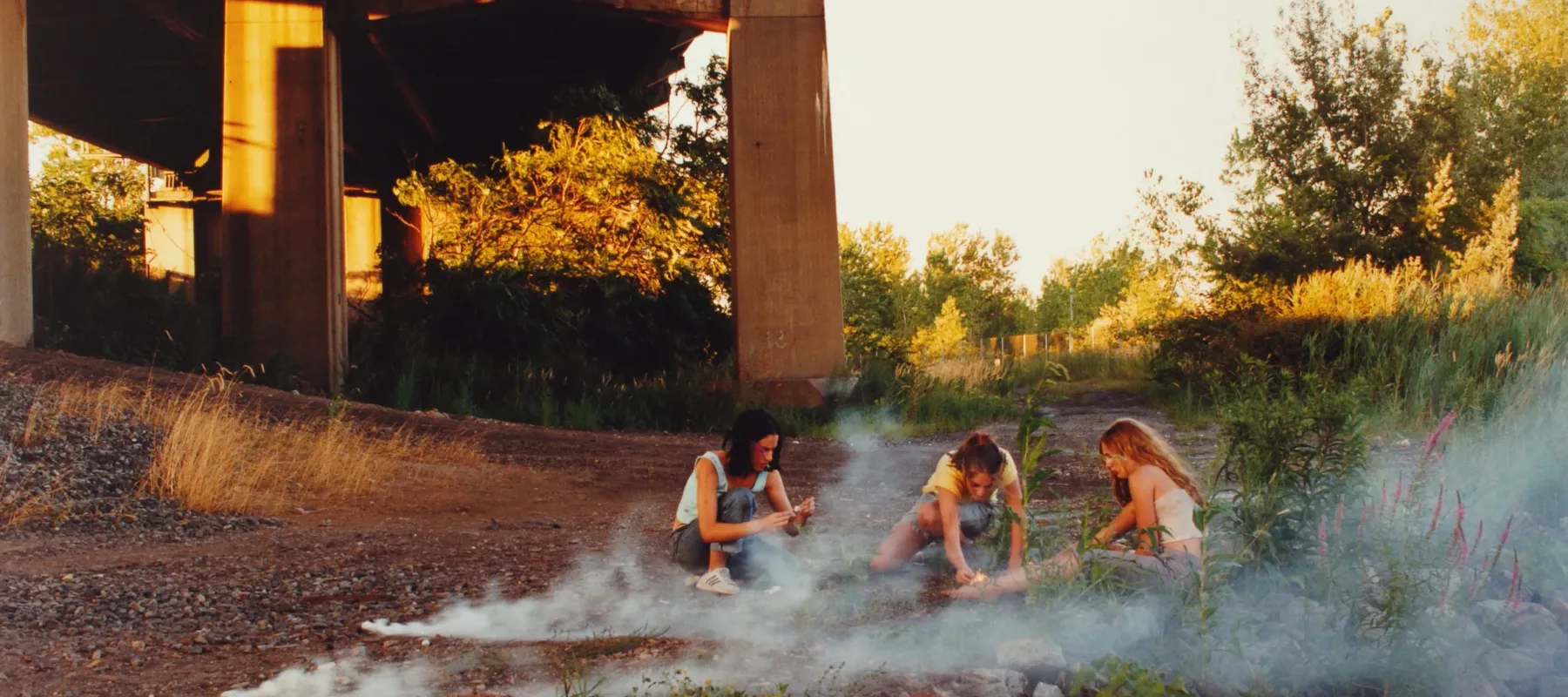WASHINGTON—The National Museum of Women in the Arts (NMWA) presents Live Dangerously, an exhibition of work by 12 photographers who use the female body as sculptural material, positioning figures in natural surroundings to suggest provocative narratives. On view Sept. 19, 2019–Jan. 20, 2020, the exhibition features work by artists Louise Dahl-Wolfe, Anna Gaskell, Dana Hoey, Mwangi Hutter, Graciela Iturbide, Kirsten Justesen, Justine Kurland, Rania Matar, Ana Mendieta, Laurie Simmons, Xaviera Simmons and Janaina Tschäpe.
Conventional art historical representations of female figures have traditionally shown women passively linked to the landscape through gendered associations of nature, eroticism and fertility. In contrast, Live Dangerously presents fierce, dreamy and witty images of women presiding over the landscape—all through the lens of the female gaze. From the literally groundbreaking work of Ana Mendieta to the first-ever installation of all 100 large-scale photographs in Janaina Tschäpe’s series “100 Little Deaths” (1996–2002), the artists illuminate the planet’s surface as a stunning stage for human drama. Coinciding with the exhibition Judy Chicago—The End: A Meditation on Death and Extinction, the works in Live Dangerously are drawn from the museum’s collection of modern and contemporary photography and enhanced by loans that illuminate the place of landscape in the construction of personal histories and identities.
“Concurrent with our presentation of Judy Chicago’s The End, this photography exhibition explores female subjects’ engagement with the Earth’s terrain,” said NMWA Director Susan Fisher Sterling. “The works in Live Dangerously turn art historical representations of women’s bodies in nature on their head to create new, empowered relationships that challenge us to see ourselves and our environment in new ways.”
On Stage
Presented in full for the first time, the immersive installation of Janaina Tschäpe’s (b. 1973) “100 Little Deaths” photograph series depicts the artist lying in fields and on beaches, pathways, terraces and forest floors in locations around the world. With results that are both startling and intentionally theatrical, Tschäpe inserts herself into these sites as a way to contemplate her own passing from the earthly realm.
Trained as an actor and photographer, Xaviera Simmons (b. 1974) uses performance to address questions of marginalized bodies in landscapes, particularly regarding womanhood and blackness in the United States. In One Day and Back Then (Standing) (2007), a self-portrait in which she gazes directly out at the viewer, Simmons appears tucked into a thicket of reeds, in a dark trench coat, crowned by a curly Afro and dressed in blackface.
Ana Mendieta (1948–1985) explored the act of physically altering or unsettling the environment through smoke and flames. In her famed Silhuetas from the 1970s, Mendieta marked outlines of her body with gunpowder or sulfur, then ignited the silhouettes, leaving traces of her corporeal form in the ground. In Volcán (1979), she transformed the silhouette into a volcano-like crater filled with live coals that emitted smoke. For the artist, burning the silhouette into the ground was a sign of returning the body to earth, a primordial source of female sexuality and power.
In Her Element
Artists in Live Dangerously claim their natural environments. Rather than appearing daunted by these extreme landscapes, figures climb, run and swim through varied terrain, freely and boldly embracing the sublime elements of nature.
Dry, arid terrain became a frequent backdrop for pioneering fashion photographer Louise Dahl-Wolfe (1895–1989). When she worked for Harper’s Bazaar magazine in the 1940s and ’50s, Dahl-Wolfe rejected studio settings and mannequin-like poses, opting instead to place models outdoors in natural light, taking them on location to exotic locales. She shot California Desert (1948) in the Mojave Desert and positioned her model so that the curves of her body subtly echo the dips of the white sand dunes.
Laurie Simmons’s (b. 1949) Water Ballet (Vertical) (1981) is part of a series that was shot in swimming pools and the clear waters of the Caribbean Sea. Directly referencing post-war Hollywood water ballets, the woman stretches her arms in graceful choreography.
For more than 30 years, Danish artist Kirsten Justesen (b. 1943) has used ice as a pivotal element in her art. In her “Ice Pedestal” series (2000, printed 2015), Justesen positions herself atop blocks of ice wearing only rubber boots and gloves, letting the ice blocks melt and then refreezing the puddles. Her photographs record this repetitive process of transition from solid to liquid to solid, capturing the idea of mutability and impermanence of the world.
Mischief-Makers
In Live Dangerously, female bodies activate the land. At times, they appear to be in precarious circumstances, and in others, they intentionally rebel and disrupt societal expectations of genteel, compliant women.
A recurrent theme is a direct encounter with trees, which serve as hiding places and surveillance perches. In Untitled #104 (A Short Story of Happenstance) (2003) by Anna Gaskell (b. 1969), a figure is inverted against a background of forest trees, cropped so the viewer only sees two legs sticking up in the air—a humorous implication that something has gone awry.

In her ongoing “She” series (2016–ongoing), Rania Matar (b. 1964) photographs young women in lush landscapes in the United States and the Middle East to portray their individual beauty through their relationships with their environments. Matar’s model in Yara, Cairo, Egypt (2019) stands partially obscured in the crevasses of a banyan tree, her limbs echoing the trunk’s vertical shoots to create an uncanny air of mystery.
In her “Phoenix” series (1999), Dana Hoey (b. 1966) orchestrates an imagined world in the American West. Helldorado (1999) casts two women as bounty hunters stalking an Old West saloon. Seen from the back, they kick up dust and dirt as they stride through a deserted town looking for outlaws, replacing the classic American trope of heroic cowboys. Like Hoey, Justine Kurland (b. 1969) scours locations with links to the 19th-century Western frontier to frame her narratives about adolescent women in the landscape. In Smoke Bombs (2000), from Kurland’s series “Girl Pictures” (1997–2002), three teenagers set off fireworks in the outdoors, their bodies crouched on the ground and enveloped by wisps of smoke. Staged as an army of teenaged runaways, her figures claim territory outside the margins of family and institutions to stand in resistance to patriarchal ideals.
The works in Live Dangerously employ humor, performance, ambiguity and inventive storytelling to reveal the ways in which female bodies inhabit, and animate, their natural surroundings. The photographers in this exhibition shed new light on the Earth’s surfaces and elements as catalysts for self-expression Live Dangerously is organized by the National Museum of Women in the Arts. The exhibition is made possible by the Sue J. Henry and Carter G. Phillips Exhibition Fund and the museum’s members. and spur profound questions about how—and where—we live our lives.
Live Dangerously is organized by the National Museum of Women in the Arts. The exhibition is made possible by the Sue J. Henry and Carter G. Phillips Exhibition Fund and the museum’s members.
National Museum of Women in the Arts
The National Museum of Women in the Arts (NMWA) is the only major museum in the world solely dedicated to championing women through the arts. With its collections, exhibitions, programs and online content, the museum seeks to inspire dynamic exchanges about art and ideas. NMWA advocates for better representation of women artists and serves as a vital center for thought leadership, community engagement and social change. NMWA addresses the gender imbalance in the presentation of art by bringing to light important women artists of the past while promoting great women artists working today. The collections highlight painting, sculpture, photography and video by artists including Louise Bourgeois, Mary Cassatt, Frida Kahlo, Shirin Neshat, Faith Ringgold, Pipilotti Rist and Élisabeth Louise Vigée-LeBrun.
NMWA is located at 1250 New York Avenue, NW, in Washington, D.C. It is open Mon.–Sat., 10 a.m.–5 p.m., and Sun., noon–5 p.m. Admission is $10 for adults, $8 for visitors 65 and over and students, and free for NMWA members and youth 18 and under. Admission is free the first Sunday of each month. For information, call 202-783-5000, visit nmwa.org, Broad Strokes Blog, Facebook, Twitter, or Instagram.
